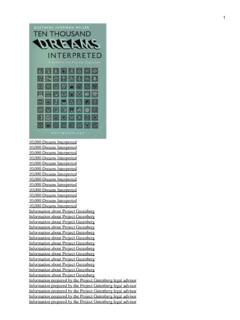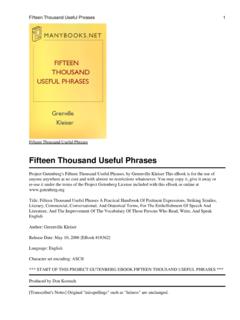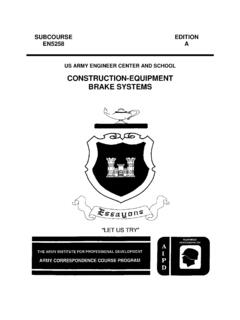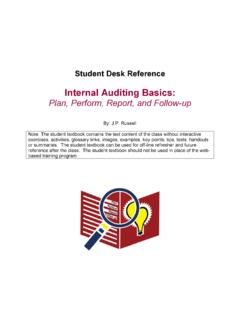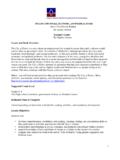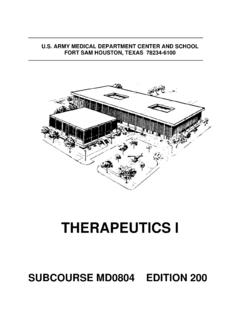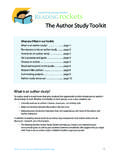Transcription of PHARMACEUTICAL CALCULATIONS - …
1 U. S. ARMY MEDICAL DEPARTMENT CENTER AND SCHOOLFORT SAM HOUSTON, TEXAS 78234 PHARMACEUTICALCALCULATIONSSUBCOURSE MD0802 EDITION 100 DEVELOPMENTThis subcourse is approved for resident and correspondence course instruction. Itreflects the current thought of the Academy of Health Sciences and conforms to printedDepartment of the Army doctrine as closely as currently possible. Development andprogress render such doctrine continuously subject to instructional systems specialist for the revision of this version of the subcourse was:Mr. John Arreguin; AMEDDC&S, ATTN: MCCS-HCP, 3151 Scott Road, Fort SamHouston, TX 78234; DSN 471-8958; subject matter expert responsible for the revision of this version of the subcoursewas: MSG Karen K. Reynolds, MCCS-HCP, Pharmacy Branch, Department of ClinicalSupport who desire credit hours for this correspondence subcourse must meeteligibility requirements and must enroll through the Nonresident Instruction Branch ofthe Army Medical Department Center and School (AMEDDC&S).
2 Application for enrollment should be made at the Internet website: You can access the course catalog in the upper right School Code 555 for medical correspondence courses. Copy down the coursenumber and title. To apply for enrollment, return to the main ATRRS screen and scrolldown the right side for ATRRS Channels. Click on SELF DEVELOPMENT to open theapplication and then follow the on screen general, eligible personnel include enlisted personnel of all components of the who hold an AMEDD MOS or MOS 18D. Officer personnel, members of otherbranches of the Armed Forces, and civilian employees will be considered eligible basedupon their AOC, NEC, AFSC or Job Series which will verify job relevance. Applicantswho wish to be considered for a waiver should submit justification to the NonresidentInstruction Branch at e-mail address: comments or questions regarding enrollment, student records, or shipments,contact the Nonresident Instruction Branch at DSN 471-5877, commercial (210) 221-5877, toll-free 1-800-344-2380; fax: 210-221-4012 or DSN 471-4012, or write to:NONRESIDENT INSTRUCTION BRANCHAMEDDC&SATTN: MCCS-HSN2105 11TH STREET SUITE 4191 FORT SAM HOUSTON TX 78234-5064MD0802 iTABLE OF CONTENTSL essonParagraphsPageINTRODUCTIONii1 PHARMACEUTICAL CALCULATIONS ISection I.
3 Review of Basic Mathematics1-1--1-201-2 Section II. Temperature Conversions1-21--1-241-27 Section III. Prescription Interpretation. 1-25--1-291-30 Section IV. Ratio and Proportion1-30--1-321-35 Section V. The Metric System1-33--1-381-45 Section VI. Common Systems of Measure1-39--1-411-58 Section VII. Reduction and Enlargement of Formulas1-42--1-441-66 Exercises1-732 PHARMACEUTICAL CALCULATIONS IISection I. Specific Gravity2-1--2-32-2 Section II. Percentage Preparations2-4--2-62-12 Section III. Dilution of Stock Preparations2-7--2-92-23 Section IV. Alligation2-10--2-132-31 Exercises2-423 PHARMACEUTICAL CALCULATIONS III3-1--3-53-2 Exercises3-10 LIST OF TABLEST ablePage2-1 Specific gravity of liquids at 25 C2-93-1 The iiCORRESPONDENCE COURSE OFTHE ARMY MEDICAL DEPARTMENT CENTER AND SCHOOLSUBCOURSE MD0802 PHARMACEUTICAL CALCULATIONSINTRODUCTIONOne of the most important areas of study for the pharmacy specialist ispharmaceutical CALCULATIONS .
4 A person might know a great deal about pharmacology,but if he cannot perform a PHARMACEUTICAL calculation , that knowledge cannot be appliedin a practical way. To prepare and dispense medications, you must be capable ofperforming a variety of PHARMACEUTICAL CALCULATIONS . You must be constantly aware ofone fact-an error made in a dosage calculation can harm a patient. The study of thissubcourse will help give you the knowledge and skill required to perform many types ofdosage subcourse is designed to focus on the systems of weights and measurescommonly used in the pharmacy. Examples in the text include drugs actually dispensedin outpatient pharmacy PHARMACEUTICAL CALCULATIONS is like building a house; one part isdependent on the other and a good firm foundation supports it all. Memorizing theformulas and equivalents, developing a well-rounded knowledge of basic mathematics,and practicing what you are learning (that is, solving practice problems) will help yousuccessfully complete this subcourse.
5 Although not required, it is advisable for you tohave completed Subcourse MD0801, Prescription Interpretation, before attempting you study this subcourse you will notice that practice problems are provided atthe end of each section. It is important that you solve these practice problems beforeyou go to the next section. Furthermore, you should complete each practice problembefore you attempt to take the final Components:This Subcourse consists of 3 lessons and an examination. The lessons are: lesson 1. PHARMACEUTICAL CALCULATIONS 2. PHARMACEUTICAL CALCULATIONS 3. PHARMACEUTICAL CALCULATIONS iiiCredit Awarded:Upon successful completion of this subcourse, you will be awarded 10 Furnished:Materials provided include this booklet, an examination answer sheet, and anenvelope. Answer sheets are not provided for individual lessons in this subcoursebecause you are to grade your own lessons.
6 Exercises and solutions for all lessons arecontained in this booklet. You must furnish a #2 for Subcourse Completion:You are encouraged to complete the subcourse lesson by lesson . When youhave completed all of the lessons to your satisfaction, fill out the examination answersheet and mail it to the Army Medical Department Center and School along withthe Student Comment Sheet in the envelope provided. Be sure that your social securitynumber is on all correspondence sent to the Army Medical Department Center andSchool. You will be notified by return mail of the examination results. Your grades onthe exam will be your rating for the Suggestions:Here are some suggestions that may be helpful to you in completing and study each lesson the subcourse lesson by lesson . After completing each lesson ,work the exercises at the end of the lesson , marking your answers in completing each set of lesson exercises, compare your answers withthose on the solutions sheet which follows the exercises.
7 If you haveanswered an exercise incorrectly, check the reference cited after the answeron the solution sheet to determine why your response was not the you successfully complete each lesson , go on to the next. When youhave completed all of the lessons, complete the examination. Mark youranswers in this booklet; then transfer your responses to the examinationanswer sheet using a #2 ivStudent Comment Sheet:Be sure to provide us with your suggestions and criticisms by filling out theStudent Comment Sheet (found at the back of this booklet) and returning it to us withyour examination answer sheet. Please review this comment sheet before studying thissubcourse. In this way, you will help us to improve the quality of this 1-1 lesson ASSIGNMENTLESSON 1 TEXT ASSIGNMENTLESSON OBJECTIVESP harmaceutical CALCULATIONS 1-1 through completing this lesson , you should be able to:1-1.
8 Perform addition, subtraction, multiplication,and division of whole numbers, fractions, anddecimals with 100 percent Convert from degrees Centigrade to degreesFahrenheit and vice Convert between the various denominations ofeach of the basic units of the metric List the conversion factors for the commonsystems which are most frequently used in Reduce or enlarge PHARMACEUTICAL formulas asrequired in the Solve PHARMACEUTICAL problems using ratio andproportion and conversion PHARMACEUTICAL CALCULATIONS using themetric studying the assignment , complete theexercises at the end of this lesson . These exerciseswill help you to achieve the lesson 1-2 lesson 1 PHARMACEUTICAL CALCULATIONS ISection I. REVIEW OF BASIC arithmetic is always involved in some manner in the solving ofpharmaceutical CALCULATIONS .
9 Perfecting basic mathematical functions will help to attainthe goal of 100 percent accuracy desired in pharmacy. Because of the need for 100percent accuracy, no partial credit will be given for setting a problem up correctly if theanswer is incorrect. In pharmacy, the correct answer is more important than if the operations performed in this lesson seem overly simple, do themfor practice/review. Most of the mistakes made by students taking this subcourse aremistakes in basic drugs have dosages expressed in fractions of a grain. Some calculationswill involve fractions, and it is important for you to have the ability to perform allmathematical procedures with fractions, whole numbers, and fraction consists of two parts: the number above the line is called theNUMERATOR and the number below the line is called the :In the fraction 1/2, 1 is the NUMERATOR and 2 is in the blanks:(1)What is the numerator in 3/4?
10 _____The numerator in 3/4 is 3.(2)What is the numerator in 9/2?_____The numerator in 9/2 is 1-3(3)What is the denominator in 7/8?_____The denominator in 7/8 is 8.(4)What is the denominator in 12/5?_____The denominator in 12/5 is fractions have the same number in the denominator, they are said tohave COMMON DENOMINATORS. For example: 1/8, 2/8, 5/8, 7/8, and 3/8 all have aCOMMON DENOMINATOR of there is a need in mathematics to find a common example, before fractions may be added or subtracted, the denominators of all thefractions in the problem must be the following rules must be applied when working with fractions:(1)If the numerator and the denominator of a fraction are multiplied by thesame number, the value will not example: Multiply the numerator and denominator of 1/2 by x 2 = 22 x 2 = 42 x 2 4 then: 4 x 2 8 , and so this example: 1/2, 2/4, and 4/8 all have the same value.
